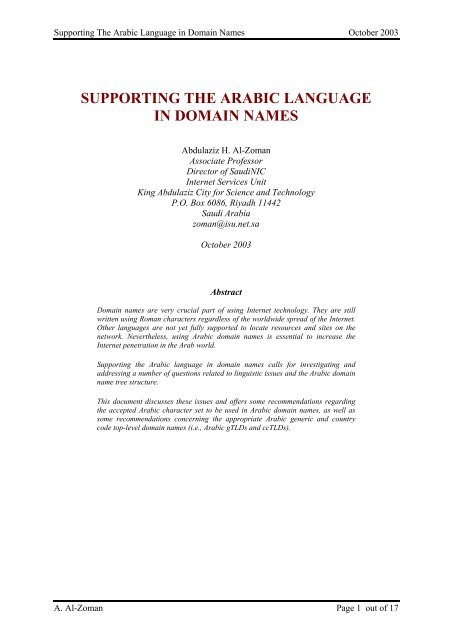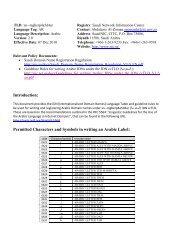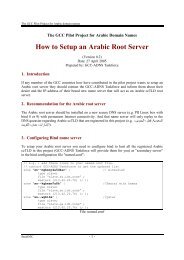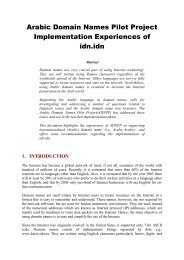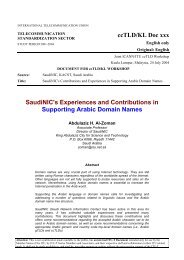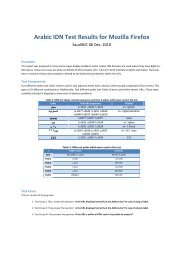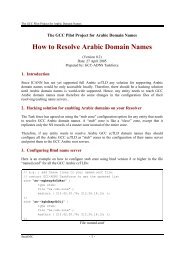SUPPORTING THE ARABIC LANGUAGE IN DOMAIN NAMES
SUPPORTING THE ARABIC LANGUAGE IN DOMAIN NAMES
SUPPORTING THE ARABIC LANGUAGE IN DOMAIN NAMES
You also want an ePaper? Increase the reach of your titles
YUMPU automatically turns print PDFs into web optimized ePapers that Google loves.
Supporting The Arabic Language in Domain Names October 2003<br />
<strong>SUPPORT<strong>IN</strong>G</strong> <strong>THE</strong> <strong>ARABIC</strong> <strong>LANGUAGE</strong><br />
<strong>IN</strong> DOMA<strong>IN</strong> <strong>NAMES</strong><br />
Abdulaziz H. Al-Zoman<br />
Associate Professor<br />
Director of SaudiNIC<br />
Internet Services Unit<br />
King Abdulaziz City for Science and Technology<br />
P.O. Box 6086, Riyadh 11442<br />
Saudi Arabia<br />
zoman@isu.net.sa<br />
October 2003<br />
Abstract<br />
Domain names are very crucial part of using Internet technology. They are still<br />
written using Roman characters regardless of the worldwide spread of the Internet.<br />
Other languages are not yet fully supported to locate resources and sites on the<br />
network. Nevertheless, using Arabic domain names is essential to increase the<br />
Internet penetration in the Arab world.<br />
Supporting the Arabic language in domain names calls for investigating and<br />
addressing a number of questions related to linguistic issues and the Arabic domain<br />
name tree structure.<br />
This document discusses these issues and offers some recommendations regarding<br />
the accepted Arabic character set to be used in Arabic domain names, as well as<br />
some recommendations concerning the appropriate Arabic generic and country<br />
code top-level domain names (i.e., Arabic gTLDs and ccTLDs).<br />
A. Al-Zoman Page 1 out of 17
Supporting The Arabic Language in Domain Names October 2003<br />
TABLE OF CONTENTS<br />
1. <strong>IN</strong>TRODUCTION .................................................................................... 3<br />
2. L<strong>IN</strong>GUISTIC ISSUES............................................................................... 4<br />
2.2. Kasheeda (Tatweel) ................................................................................. 5<br />
2.3. Character folding.................................................................................... 5<br />
2.4. Numbers ............................................................................................... 6<br />
2.5. Connecting Multiple Words ...................................................................... 6<br />
2.6. A<strong>IN</strong>C-ALC Recommendations................................................................... 6<br />
2.7. Supported Character Set .......................................................................... 8<br />
3. <strong>ARABIC</strong> TOP-LEVEL DOMA<strong>IN</strong> <strong>NAMES</strong> ..................................................... 9<br />
3.1. Current Suggestions for Arabic TLDs ........................................................10<br />
3.1.1. Suggested Arabic gTLDs .......................................................................10<br />
3.1.2. Suggested Arabic ccTLDs......................................................................11<br />
3.1.2. Results of the Study..............................................................................12<br />
3.2. Open Issues ..........................................................................................13<br />
3.2.1. Full words vs. Abbreviations ..................................................................14<br />
3.2.2. The Arabic Equivalent of "WWW" ........................................................14<br />
3.2.3. Arabic TLD Categories.........................................................................14<br />
3.2.4. Arabic Domain Name Structure..............................................................15<br />
2.3 Recommended Arabic gTLDs and ccTLDs ...................................................15<br />
REFERENCES............................................................................................17<br />
A. Al-Zoman Page 2 out of 17
Supporting The Arabic Language in Domain Names October 2003<br />
1. <strong>IN</strong>TRODUCTION<br />
The Internet has become a global network of most if not all countries of the world with<br />
hundred of millions of users. Recently, it is estimated that more than 60% of the Internet<br />
contents are in languages other than English. Also, it is estimated that by the year 2003 there<br />
will at least 30% of web users who prefer to do their on-line activities in a language other than<br />
English, and that by 2005 only one third of Internet businesses will use English for on-line<br />
communication [1,2].<br />
Domain names are used widely by Internet users to locate resources on the Internet in a<br />
format that is easy to remember and understand. These names, however, are not required by<br />
the network software, but are used for human mnemonic convenience. They are used instead<br />
of the numerical addresses which are known as Internet protocol (IP) addresses, which are<br />
mainly used by machines to route data packets on the Internet. Hence, the main objective of<br />
using domain names is to ease and simplify the use of the Internet [3,4,5].<br />
Since the Internet was originally evolved in the United Sates, it supported only 7-bit ASCII<br />
code. Domain names consist of alphanumeric strings separated by dots, e.g.,<br />
www.kacst.edu.sa. They are written using Roman characters particularly letters, digits, and<br />
hyphen. To the network, however, a domain name such as “www.kacst.edu.sa” is meaningless<br />
until it is translated into a numerical IP address. Name resolution is carried out by the Internet<br />
domain name system (DNS) in that domain names are mapped to the actual corresponding IP<br />
addresses.<br />
Regardless of the worldwide spread of the Internet, the Internet penetration in the Arab world<br />
is about 1.4% [6] which is indeed very low. One of the obstacles facing the growth of this<br />
penetration is the language burier. The Internet domain name system has not fully supported<br />
other languages to locate resources on the Internet. Users in non-English speaking countries,<br />
such as the Arab users, are in disadvantages. Using domain names in a language that is<br />
different from the users' native language defeats the main objective of having the domain<br />
name in characters rather than just numbers.<br />
Hence, it is important to make the Internet support the Arabic language not only in web<br />
contents but also in their addresses. It is required that the Arabic language should be used<br />
from the start of switching on the user's personal computer till getting information from the<br />
Internet. Thus, eliminating the need for the user to enter non-Arabic web (URL) addresses<br />
particularly if the sites are in Arabic. There are a number of reasons why Arabizing domain<br />
names is needed [7], such as:<br />
• Making the Arabic language part of the Internet.<br />
• There is a small percentage of Arabs who can read and write in English.<br />
• There are many well-known Arabic names that need to be used in the Internet.<br />
• Users in the Arab world should have privileges to use their language on the Internet same<br />
as English-speaking users.<br />
• Roman letters are not capable of representing (or substituting) Arabic letters.<br />
• Encouraging the use of the Internet by Arabs who do not speak English. As the trend<br />
nowadays for implementing e-government and e-business then it is important to provide<br />
the information and services using the user native language.<br />
A. Al-Zoman Page 3 out of 17
Supporting The Arabic Language in Domain Names October 2003<br />
This need is not only for the Arabic language but also for other languages. Multilingual<br />
domain names were first developed in Asia-Pacific countries in 1998 [1,2,8,9], which led later<br />
to the creation of a number of non-for profit organizations to supervise and pursuing the<br />
deployment of multilingual domain names. Among these organizations are: the Multilingual<br />
Internet Names Consortium (M<strong>IN</strong>C), the Arabic Internet Names Consortium (A<strong>IN</strong>C), the<br />
Arabic Domain Name Task Force (ADNTF) under the supervision of UN-ESCWA, the<br />
Chinese Domain Name Consortium (CDNC), the International Forum for IT in Tamil<br />
(<strong>IN</strong>FITT), and the Japanese Domain Names Association (JDNA). Also, the Internet<br />
Corporation for Assigned Names and Numbers (ICANN) established an internal<br />
Internationalized Domain Name (IDN) Working Group, and the Internet Engineering Task<br />
Force (IETF) created an internationalized DNS group that have been dedicated for exploring<br />
the possibility of supporting internationalize Internet. The IDN group of IETF has issued so<br />
far three Request For Comments (RFC) for Internationalized DNS [10,11,12].<br />
Several companies have begun to commercialize the technologies that have been developed to<br />
support multilingual domain names. These developments lack the standardized references.<br />
This is because, as usual, vendors are faster than the standardized bodies for proposing<br />
solutions. Therefore, current implementations of multilingual domain names are using<br />
proprietary technologies. ICANN adopted a resolution which recognizes that “it is important<br />
that the Internet evolves to be more accessible to those who do not use the ASCII-character<br />
set”, and stresses that “the internationalization of the Internet domain name system must be<br />
accomplished through standards that are open, non-proprietary, and fully compatible with the<br />
Internet’s existing end-to-end model and that preserve the globally unique naming in a<br />
universally resolvable public space” [13]. Hence, adopting proprietary solutions may lead to:<br />
• Unrecognition by the international bodied such as ICANN and IETF.<br />
• Incompatible solutions from technical and linguistic point of view.<br />
• Multiple registrations for the same category.<br />
• Disjoint networks each with its own an Arabic domain name space.<br />
Therefore, it is urgently required from the Arabic Internet community to produces a set of<br />
standards that are acceptable by the Internet community in large. These standards should<br />
cover several aspects of supporting Arabic domain names in deferent levels, such as:<br />
1. Linguistic issues and the accepted Arabic character set.<br />
2. The Arabic domain name tree structure, i.e., Arabic gTLDs and ccTLDs.<br />
3. Technical solutions to Arabize the domain name system<br />
4. The administrative and organizational issues of Arabic root servers.<br />
This document addresses only the first two issues.<br />
2. L<strong>IN</strong>GUISTIC ISSUES<br />
There are a number of linguistic issues that have to be discussed and agreed upon with respect<br />
to the usage of the Arabic language in domain names. This section will highlight some of<br />
them. For more detailed discussion see [7, 14].<br />
A. Al-Zoman Page 4 out of 17
Supporting The Arabic Language in Domain Names October 2003<br />
2.1. Al-Tashkeel (Diacritics)<br />
Al-Tashkeel (diacritic) is a small singe that is usually put on top or under an Arabic letter for<br />
the purpose of correct pronunciation which may leads to a different meaning. Al-tashkeel is<br />
not a letter by itself but it is a mean to correctly pronounce a letter. It is not widely used<br />
except incase of the possibility of mispronouncing words that have the same letters but with<br />
different pronunciations, and hence having different meanings.<br />
Recommendation: With respect to domain names, al-tashkeel can be supported only in the<br />
user interface but should not be stored in the zone file. Therefore, it can<br />
be striped off at the preparation of internationalized strings ("stringprep")<br />
phase.<br />
2.2. Kasheeda (Tatweel)<br />
Kasheeda is not a letter. It is a horizontal line (like dash) used to lengthen the connection line<br />
between letters. It is used sometimes to enhance the display of Arabic words on screens or<br />
printouts.<br />
Recommendation: Kasheeda should not be used in Arabic domain names.<br />
2.3. Character folding<br />
A character folding is the process where multiple letters (that may have some similarity with<br />
respect to their shapes) are folded into one shape. This includes:<br />
- Folding Teh Marbuta and Heh at the end of a word.<br />
- Folding different forms of Hamzah.<br />
- Folding Alif Maksura and Yeh at the end of a word.<br />
- Folding Waw with Hamzah and Waw.<br />
With respect to Arabic language, character folding is unacceptable because it changes the<br />
meaning of the words and it is against the simplest spelling rules. Replacing a character with<br />
another character, which may have the same shape but different pronunciation, will give a<br />
different meaning. This will lead to have only one form (word) out many other forms of<br />
words that are made by all the combination of folded characters. Hence, the other forms will<br />
be masked by the common form.<br />
It is often that because of laziness or weakness in spelling, hand writing mixes between<br />
different characters (e.g., Heh and Teh-Marbuta). However, this is not the case in published<br />
and printed materials. One of the motivations to support the Arabic language in domain<br />
names is to preserve the language particularly with the spread of the globalization movement.<br />
Hence, character folding is working against this motivation since it is going to have a negative<br />
affect on the principle and ethics of the language. Therefore, we should let the technology<br />
works for the language and not the other way.<br />
Recommendation: Character folding should not be allowed.<br />
A. Al-Zoman Page 5 out of 17
Supporting The Arabic Language in Domain Names October 2003<br />
2.4. Numbers<br />
In the Arab world, there are two sets of numerical digits used:<br />
- Set I: (0, 1, 2, 3, 4, 5, 6, 7, 8, 9),<br />
Mostly used in the western part of the Arab world (al-maghrib al-arabi).<br />
- Set II: ( ٩ ،٨ ،٧ ،٦ ،٥ ،٤ ،٣ ،٢ ،١ ، ٠),<br />
Mostly used in the eastern part of the Arab world (al-mashriq al-arabi).<br />
There have been some suggestions to use Set I because it is though that there is similarity (or<br />
confusion) between the Arabic zero (0) and the dot (.). But the differences appear clearly in<br />
publications. The zero is larger and is printed higher than the dot. Also, With respect to a<br />
domain name, it is quite easy to distinguish between the zero and the dot based on the context<br />
of the domain name. And since the two sets are used they should be both supported.<br />
Recommendation: Both sets should be supported in the user interface and both are folded to<br />
one set (Set I) at the preparation of internationalized strings (e.g.,<br />
"stringprep") phase.<br />
2.5. Connecting Multiple Words<br />
In the Arab language words are separated by spaces. Connecting words without spaces is<br />
usually not acceptable. Therefore, a single space is the best word separator in an Arabic<br />
domain name with multiple words.<br />
Recommendation: Space should be used to separate words if it is technically visible.<br />
Otherwise, it is recommended that multiple words are separated by the<br />
character "-" dash.<br />
If the space is used as a word separator in Arabic domain names then it<br />
should be only a single space and it should not be used at the beginning<br />
or at the end of words.<br />
2.6. A<strong>IN</strong>C-ALC Recommendations<br />
There are some non-for-profit international organizations that are trying to promote the<br />
multilingual issues and standards on the Internet, such as A<strong>IN</strong>C (Arabic Internet Names<br />
Consortium). One of the strategic tasks of A<strong>IN</strong>C is to setup some linguistic guidelines to be<br />
used by technology providers. Therefore, an Arabic Linguistic Committee was established<br />
during the formation of A<strong>IN</strong>C in April 2000 to carry this task. One of the main goals of the<br />
committee is to define the accepted Arabic character set to be used for writing domain names<br />
in Arabic.<br />
Table (I) lists Arabic Linguistic Committee recommendations [14] regarding some linguistic<br />
issues. More detailed information can be found in the following URL:<br />
http://www.saudinic.net.sa/arabicdomain/arabic_domains.htm:<br />
A. Al-Zoman Page 6 out of 17
Supporting The Arabic Language in Domain Names October 2003<br />
Table I: A<strong>IN</strong>C-ALC Recommendations<br />
Issue<br />
Tashkeel (Diacritics)<br />
Kasheeda<br />
Folding Teh Marbuta +<br />
Heh<br />
Folding different forms<br />
of Hamzah<br />
Folding Alif<br />
Maqsura+Ya<br />
Numbers<br />
Arabic Zero<br />
Connecting Multiple<br />
Words<br />
Spaces<br />
Mixing Latin and<br />
Arabic Characters<br />
Special Characters (e.g.,<br />
@, #, $, %, ...)<br />
ACCEPTED<br />
CHARACTER SET<br />
Recommendations<br />
Tashkeel should not be allowed. However, if<br />
there is a need to allowed users to entered<br />
Tashkeel as part of a domain name then it<br />
should be stripped off by nameprep<br />
Kasheeda should be disallowed<br />
Folding should not be allowed<br />
If it is technically possible, it is preferred to<br />
support both (Latin and Arabic) sets with<br />
folding to one set. Otherwise, Latin set is<br />
sufficient<br />
It is recommended that multiple words are<br />
separated by the character "-".<br />
It is recommended that Arabic domain names<br />
be pure Arabic and they should not be mixed<br />
with other languages.<br />
It is recommended that Arabic domain names<br />
should follow the standard with respect to the<br />
use of special characters.<br />
It is recommended to use UNICODE 3.1. The<br />
following Unicode characters are accepted in<br />
Arabic domain names:<br />
U0621(hamza) until U063A (gheen)<br />
U0641 (feh) until U064A (yeh)<br />
Arabic numbers: ٩ -٠<br />
(U0660 until U0669)<br />
Latin numbers: 0-9 (U0030 – U0039)<br />
Hyphen (U002D)<br />
Dot (U002E)<br />
Other than these characters are not allowed<br />
A. Al-Zoman Page 7 out of 17
Supporting The Arabic Language in Domain Names October 2003<br />
2.7. Supported Character Set<br />
It is recommended to use only the following Unicode characters. These are based on the study<br />
in [7] and the report from the Arabic linguistic committee of A<strong>IN</strong>C [14]. The following codes<br />
are based on Unicode version 3.1 [15].<br />
Characters from Unicode Arabic Table (0600–06FF)<br />
0621<br />
(ء) <strong>ARABIC</strong> LETTER HAMZA 0622<br />
(آ) <strong>ARABIC</strong> LETTER ALEF WITH MADDA ABOVE 0623<br />
(أ) <strong>ARABIC</strong> LETTER ALEF WITH HAMZA ABOVE 0624<br />
(ؤ) <strong>ARABIC</strong> LETTER WAW WITH HAMZA ABOVE 0625<br />
(إ) <strong>ARABIC</strong> LETTER ALEF WITH HAMZA BELOW 0626<br />
(ئ) <strong>ARABIC</strong> LETTER YEH WITH HAMZA ABOVE 0627<br />
(ا) <strong>ARABIC</strong> LETTER ALEF 0628<br />
<strong>ARABIC</strong> LETTER BEH (ب) 0629<br />
(ة) <strong>ARABIC</strong> LETTER TEH MARBUTA 062A (ت) <strong>ARABIC</strong> LETTER TEH<br />
062B (ث) <strong>ARABIC</strong> LETTER <strong>THE</strong>H<br />
062C (ج) <strong>ARABIC</strong> LETTER JEEM<br />
062D (ح) <strong>ARABIC</strong> LETTER HAH<br />
062E (خ) <strong>ARABIC</strong> LETTER KHAH<br />
062F (د) <strong>ARABIC</strong> LETTER DAL<br />
0630<br />
(ذ) <strong>ARABIC</strong> LETTER THAL 0631<br />
(ر) <strong>ARABIC</strong> LETTER REH 0632<br />
(ز) <strong>ARABIC</strong> LETTER ZA<strong>IN</strong> 0633<br />
<strong>ARABIC</strong> LETTER SEEN (س) 0634<br />
<strong>ARABIC</strong> LETTER SHEEN (ش) 0635<br />
<strong>ARABIC</strong> LETTER SAD (ص) 0636<br />
<strong>ARABIC</strong> LETTER DAD (ض) 0637<br />
(ط) <strong>ARABIC</strong> LETTER TAH 0638<br />
(ظ) <strong>ARABIC</strong> LETTER ZAH 0639<br />
(ع) <strong>ARABIC</strong> LETTER A<strong>IN</strong> 063A (غ) <strong>ARABIC</strong> LETTER GHA<strong>IN</strong><br />
0641<br />
<strong>ARABIC</strong> LETTER FEH (ف) 0642<br />
(ق) <strong>ARABIC</strong> LETTER QAF 0643<br />
(ك) <strong>ARABIC</strong> LETTER KAF 0644<br />
(ل) <strong>ARABIC</strong> LETTER LAM 0645<br />
(م) <strong>ARABIC</strong> LETTER MEEM 0646<br />
(ن) <strong>ARABIC</strong> LETTER NOON 0647<br />
(ه) <strong>ARABIC</strong> LETTER HEH 0648<br />
(و) <strong>ARABIC</strong> LETTER WAW 0649<br />
(ى) <strong>ARABIC</strong> LETTER ALEF MAKSURA 064A (ي) <strong>ARABIC</strong> LETTER YEH<br />
0660 (٠) <strong>ARABIC</strong>-<strong>IN</strong>DIC DIGIT ZERO<br />
0661 (١) <strong>ARABIC</strong>-<strong>IN</strong>DIC DIGIT ONE<br />
0662 (٢) <strong>ARABIC</strong>-<strong>IN</strong>DIC DIGIT TWO<br />
0663 (٣) <strong>ARABIC</strong>-<strong>IN</strong>DIC DIGIT THREE<br />
0664 (٤) <strong>ARABIC</strong>-<strong>IN</strong>DIC DIGIT FOUR<br />
0665 (٥) <strong>ARABIC</strong>-<strong>IN</strong>DIC DIGIT FIVE<br />
0666 (٦) <strong>ARABIC</strong>-<strong>IN</strong>DIC DIGIT SIX<br />
A. Al-Zoman Page 8 out of 17
Supporting The Arabic Language in Domain Names October 2003<br />
0667 (٧) <strong>ARABIC</strong>-<strong>IN</strong>DIC DIGIT SEVEN<br />
0668 (٨) <strong>ARABIC</strong>-<strong>IN</strong>DIC DIGIT EIGHT<br />
0669 (٩) <strong>ARABIC</strong>-<strong>IN</strong>DIC DIGIT N<strong>IN</strong>E<br />
Characters from Unicode Basic Latin Table (0000–007F):<br />
0030 (0) DIGIT ZERO<br />
0031 (1) DIGIT ONE<br />
0032 (2) DIGIT TWO<br />
0033 (3) DIGIT THREE<br />
0034 (4) DIGIT FOUR<br />
0035 (5) DIGIT FIVE<br />
0036 (6) DIGIT SIX<br />
0037 (7) DIGIT SEVEN<br />
0038 (8) DIGIT EIGHT<br />
0039 (9) DIGIT N<strong>IN</strong>E<br />
002D (-) HYPHEN-M<strong>IN</strong>US<br />
002E (.) FULL STOP (Dot)<br />
3. <strong>ARABIC</strong> TOP-LEVEL DOMA<strong>IN</strong> <strong>NAMES</strong><br />
The domain name system (DNS) is basically a distributed database of host information that is<br />
organized in a hierarchal tree structure [3], see Figure (1). Theoretically, there is a "root<br />
domain" at the top of the domain name tree which is usually left unnamed. Immediately<br />
underneath the root come the top-level domains (TLDs). Basically, there are tow types of<br />
TLDs [3]. One is the generic TLDs (gTLDs), such as .com, .org, .net, and .edu. The second<br />
one is the country code TLDs (ccTLDs), such as .ae (United Arab Emirates), .bh (Bahrain),<br />
.ca (Canada), .de (Germany), .eg (Egypt), .jo (Jordan), .kw (Kuwait), .om (Oman), .qa (Qatar),<br />
.sa (Saudi Arabia), and .uk (United Kingdom). There are more than 240 ccTLDs following<br />
the two-letter country codes defined in the ISO standard number 3166 [16].<br />
Figure 1: Domain Name Tree Structure<br />
A domain name, whether under a gTLD or ccTLD offers a global presence which makes sure<br />
that the corresponding web site is accessible through the Internet from anywhere. More than<br />
170 millions of such names are estimated to be already stored in the Internet domain name<br />
system [17].<br />
A. Al-Zoman Page 9 out of 17
Supporting The Arabic Language in Domain Names October 2003<br />
Part of supporting the Arabic language in domain names is defining the Arabic domain name<br />
tree structure. This means that the Arabic Internet community should produce a set of agreed<br />
upon Arabic gTLDs and ccTLDs.<br />
3.1. Current Suggestions for Arabic TLDs<br />
There have been some suggestions with respect to the Arabic gTLDs and ccTLDs. They were<br />
studied and compare in [18]. The following subsections will summarize what has been found<br />
in this study.<br />
3.1.1. Suggested Arabic gTLDs<br />
There are three main suggestions for Arabic gTLDs proposed by vendors and researchers.<br />
Table (II) lists the suggested Arabic gTLDs with the corresponding English gTLDs. These<br />
suggestions are:<br />
1. Single Letter (SL):<br />
A single letter is used as an Arabic gTLD. For example, the Arabic letter "ش" is used for<br />
the Arabic gTLD corresponding to the English gTLD ".com" and the letter "م" is used for<br />
the gTLD corresponding to the English gTLD ".org".<br />
2. Word Root (WR):<br />
The root of the Arabic word corresponding to an English gTLD is used for the Arabic<br />
gTLD. For example, the root (" ("شرك of the Arabic word " "شرآة is corresponding to<br />
the English gTLD ".com" and the root ("نظم") of the Arabic word "منظمة" is<br />
corresponding to the English gTLD ".org".<br />
3. Full Word (FW):<br />
A full Arabic word that corresponds to an English gTLD is used. For example, the Arabic<br />
word "شرآة" is used for the Arabic gTLD corresponding to the English gTLD ".com" and<br />
the Arabic word "منظمة" is used for the Arabic gTLD corresponding to the English gTLD<br />
".org".<br />
Table II: Proposed Arabic gTLDs<br />
English gTLDs<br />
com<br />
SL<br />
FW<br />
WR<br />
شرك<br />
ش شركة<br />
net<br />
شبك<br />
ك شبكة<br />
edu<br />
علم<br />
ت تعليمي<br />
gov<br />
حكم<br />
ح حكومي<br />
org<br />
نظم<br />
م منظمة<br />
mil<br />
عسكر<br />
ع عسكري<br />
int<br />
دول<br />
د دولي<br />
aero<br />
طير<br />
ط طيران<br />
A. Al-Zoman Page 10 out of 17
Supporting The Arabic Language in Domain Names October 2003<br />
coop<br />
عون<br />
ن تعاون<br />
name<br />
وسم<br />
س شخص<br />
biz<br />
عمل<br />
ل أعمال<br />
info<br />
خبر أو طلع<br />
خ إعلام<br />
Museum<br />
تحف<br />
ف متحف<br />
3.1.2. Suggested Arabic ccTLDs<br />
There are four main suggestions for Arabic ccTLDs discussed by the Arab Internet<br />
community. Table (III) lists these suggestions for all members of the Arabic League. These<br />
suggestions are:<br />
1. Short Form:<br />
This suggestion proposes the use of the short forms of country names based on the Arab<br />
standard specifications No. 642-1985, "Codes for names of Countries and Languages"<br />
[19].<br />
:(ال) 2. Short Form without<br />
This is similar to suggestion (1) but without "ال" for the purpose to shorten the length of<br />
the Arabic ccTLDs.<br />
3. Nationality:<br />
This suggestion proposes the use of the nationality descriptive of each country.<br />
4. Country Code:<br />
This suggestion proposes the use of the 2-letter country codes based on the Arab standard<br />
specifications No. 642-1985, "Codes for names of Countries and Languages" [19], which<br />
is the equivalent to the ISO 3166 standard [16].<br />
Country Official Country Code<br />
Names English Arabic<br />
Hashemite<br />
Kingdom of<br />
Jordan<br />
United Arab<br />
Emirates<br />
Kingdom of<br />
Bahrain<br />
Republic of<br />
Tunisia<br />
People's<br />
Democratic<br />
Republic of<br />
Algeria<br />
Table III: Proposed Arabic ccTLDs<br />
Nationality<br />
Short Name<br />
Short Name<br />
(ال) without<br />
أردن الأردن أردني ار jo<br />
إمارات الإمارات إماراتي ام ae<br />
بحرين البحرين بحريني بح bh<br />
تونس تونس تونس ي تو tn<br />
جزائر الجزائر جزائر ي جز dz<br />
جزر القمر جزر القمر ي قمر قم Federal and km<br />
A. Al-Zoman Page 11 out of 17
Supporting The Arabic Language in Domain Names October 2003<br />
Islamic Republic<br />
of Comoros<br />
Republic of<br />
Djibouti<br />
Kingdom of Saudi<br />
Arabia<br />
Democratic<br />
Republic of Sudan<br />
Syria Arab<br />
Republic<br />
Somalia<br />
Democratic<br />
Republic<br />
جيبوتي جيبوتي جيبوتي جي dj<br />
سعودية السعودية سعودي سع sa<br />
سودان السودان سودان ي سد sd<br />
سورية سورية سوري سر sy<br />
صومال الصومال صوما لي صو so<br />
Republic of Iraq iq<br />
عر عراق Sultanate of<br />
Oman<br />
Palestine ps<br />
فل فلسطين State of Qatar qa<br />
قط قطر Stat of Kuwait kw<br />
آو آويت Lebanese<br />
Republic<br />
Socialist People's<br />
Libyan Arab<br />
Jamahiriya<br />
Arab Republic of<br />
Egypt<br />
Kingdom of<br />
Morocco<br />
Islamic Republic<br />
of Mauritania<br />
Yemen Arab<br />
Republic<br />
عراق العراق ي<br />
عمان عمان عمان ي عم om<br />
ي<br />
فلسطين فلسطين ي<br />
ق طر قطر<br />
ي<br />
الكويت آويت لبنان لبنان لبنان ي لب lb<br />
ليبيا ليبيا ليبي لي ly<br />
مصر مصر مص ري مص eg<br />
مغرب المغرب مغر بي مغ ma<br />
موريتاني ا موريتاني ا موريتاني مو mr<br />
يمن اليمن يمن ي يم ye<br />
3.1.3. Results of the Study<br />
These suggested Arabic gTLDs and ccTLDs were studied and compared using the following<br />
criteria [18]:<br />
1. Length of the Arabic TLDs.<br />
2. Coherence and Clarity of the Arabic TLDs, .i.e., how much easy to associate an<br />
Arabic TLD with its corresponding category.<br />
3. Linguistic structure of the Arabic domain name, i.e., consistency with the Arabic<br />
language.<br />
4. Easiness of pronunciation of the Arabic TLDs.<br />
5. Future expansion of more Arabic TLDs (i.e., extendibility).<br />
Additional two factors were used, for comparing Arabic ccTLDs, namely:<br />
6. Undesirable code for Arabic ccTLDs. This factor indicates whether the proposed<br />
Arabic ccTLDs introduce undesirable Arabic words. This is particularly if arbitrary<br />
combination of Arabic characters is used to produce an Arabic ccTLD.<br />
7. The easy of reaching consensus among the involved parties (e.g., Arab countries).<br />
A. Al-Zoman Page 12 out of 17
Supporting The Arabic Language in Domain Names October 2003<br />
Here are some major points from the study:<br />
• With respect to the length of the proposed Arabic gTLDs and ccTLDs it is obvious that<br />
using single letter for a gTLD and 2-letter country code for ccTLD give the best score.<br />
• Arabic gTLDs that are based on full words are much clearer than Arabic gTLDs that are<br />
based only on single letters. For example, the full Arabic word " "شبكة is much clearer than<br />
just a single letter "ك" for representing the category "network".<br />
• Most of the proposed Arabic gTLDs are basically based on one-to-one translation of the<br />
English gTLDs either using full words or single letters, which might not suite the Arabic<br />
language. This means that the name of the entity comes before its category (i.e., gTLD).<br />
For example, the domain name of "the food and agriculture organization (fao)" is<br />
"fao.org"; the actual name and the domain name both have the entity type<br />
(organization/org) at the end. However, for the proposed Arabic gTLDs particularly the<br />
use of full words presents unpleasant structure of a domain name from linguistic point of<br />
view. For example, Table (IV) depicts examples of some Arabic domain names in which<br />
the Arabic linguistic structure of domain names is sound awkward.<br />
Table IV: Example of some Arabic Domain Names<br />
Entity name Type Arabic domain name<br />
اتحاد السباحة العربي<br />
(منظمة) org اتحاد-السباحة-العربي. منظمة شرآة الأمانة<br />
(شرآة) com الأمانة شرآة الشبكة العربية للمعلومات<br />
(شبكة) net عربية شبكة • Pronouncing single letters or full words much easer than word roots.<br />
• Using single letters is limited to 28 possible Arabic gTLDs because there are only 28<br />
letters in the Arabic character set. Using word roots has little limitation in which multiple<br />
words may give the same root, e.g., the following words: " "تعليم and " "إعلام have the same<br />
root ."علم" While using full words virtually has no limitation.<br />
• It has been found that using Arabic full words for gTLDs is more suitable for the Arabic<br />
language. This is because they are straightforward to relate to the corresponding<br />
categories and easy to pronounce.<br />
• With respect to the proposed Arabic ccTLDs, it has been found that using the Arabic<br />
standard for country codes would be the easiest and fastest way to reach agreements<br />
among the concerned parties. Also, it is quite comprehensive which include most of the<br />
world's countries. This is said despite its shortcoming of having some unpleasant codes.<br />
Enhancement to the standard to overcome this problem can be done for certain country<br />
."قطر " and "مصر " example, codes to become three letters rather than two letters. For<br />
However, from pure linguistic point of view, the use of nationality (the second proposal)<br />
would be recommended.<br />
3.2. Open Issues<br />
Most of the proposed Arabic gTLDs are basically based on one-to-one translation of the<br />
English gTLDs either using full words or single letters. They are based on the activities of the<br />
entities (i.e., commercial, government, education) which might not suite the Arabic language.<br />
This is due to the fact that the entity category in Arabic (i.e., منظمة ، ...) comes in front of<br />
the entity name and not at the end. Hence, this leads to creating awkward Arabic domain<br />
names.<br />
.<br />
.<br />
شرآة<br />
A. Al-Zoman Page 13 out of 17
Supporting The Arabic Language in Domain Names October 2003<br />
Therefore this section will list three major issues related to the selection of the proper Arabic<br />
TLDs.<br />
3.2.1. Full words vs. Abbreviations<br />
In general, abbreviations are not widely used in Arabic language. Even if they are used they<br />
are pronounced in full wording. For example, the Arabic abbreviation ( .ب ) is used but its<br />
انتهى ( pronounced ) is used but its ه ( abbreviation also the Arabic ,(صندوق بريد) pronounced<br />
Thus, the use of full words in domain names will be more acceptable than .(آلامه<br />
abbreviations. This applicable to both Arabic gTLDs and ccTLDs.<br />
3.2.2. The Arabic Equivalent of "WWW"<br />
Do we really need an Arabic equivalent to the English prefix "www" in domain names? Some<br />
suggested using the Arabic word " ."موقع However, knowing that the inventor of the "www"<br />
has regretted the introduction of this prefix, put us in advantages to not make the same<br />
mistake. Therefore, there should be no need for a specific prefix to identify web locations in<br />
the Internet. Domain names without prefixes will be sufficient to locate these sites.<br />
3.2.3. Arabic TLD Categories<br />
The activity type (e.g., commercial, government, network, …) is used in defining English<br />
gTLDs (e.g., .com, .gov,. .net, …). This classification might not be the right choice for the<br />
Arabic gTLDs. This is due to the fact that activity type in Arabic (i.e., منظمة ، ...) comes in<br />
front of the entity name and not at the end. Hence, this leads to creating awkward Arabic<br />
domain names.<br />
Geographical classification is widely used in Arabic language for indenting people, entities,<br />
and products. The geographical descriptive words usually come at the end of the phrase.<br />
Table (V) lists some examples.<br />
ص<br />
شرآة<br />
Table V: Examples of Arabic Names with Geographical Descriptive Words<br />
أ<br />
أبو إسماعيل البخاري<br />
قناة السويس<br />
اتحاد آرة الطائرة السعودي<br />
جمعية الحاسبات السورية<br />
حزب العمل اللبناني<br />
نادي الأهلي المصري<br />
حمص حلبي<br />
مشمش شامي<br />
شاهي مغربي<br />
فرس عربي<br />
دينار آويتي<br />
جامعة الدول العربية<br />
A. Al-Zoman Page 14 out of 17
Supporting The Arabic Language in Domain Names October 2003<br />
3.2.4. Arabic Domain Name Structure<br />
A domain name consists of multiple words (codes) that are separated by dots. The following<br />
could be the proposed Arabic domain name structure based on the assumption that the<br />
geographical classification is adopted:<br />
.<br />
Where, represents the Arabic name of the entity, and represents an<br />
Arabic TLD. For example,<br />
شرآة-الزومان. سعودية<br />
شرآة-أرامكو. سعودية<br />
المرآز-التجاري. سورية<br />
اتحاد-آرة-الطائرة.عر بي<br />
جامعة-الخرطوم. سودان<br />
2.3 Recommended Arabic gTLDs and ccTLDs<br />
Based on the discussions in the previous sections, the current suggested Arabic gTLDs which<br />
use the entity type for the classification are not suitable for the Arabic language. Therefore, it<br />
is suggested to use the geographical classification instead.<br />
With respect to Arabic gTLDs, it is recommended to use geographical descriptive words such<br />
as " "دولي and " ."عربي In later phase (if needed) other Arabic gTLDs can be added which<br />
."معلوماتي" represents activities such as " " " ", and<br />
تجاري<br />
تعليمي<br />
With respect to Arabic ccTLDs, it is recommended to use a full word either the nationalities<br />
.(ال) or the short country names without<br />
Figure (2) show the suggested Arabic domain name tree structure whether using country<br />
codes or nationalities for the Arabic ccTLDs.<br />
A. Al-Zoman Page 15 out of 17
Supporting The Arabic Language in Domain Names October 2003<br />
Figure 2: Arabic Domain Name Tree Structure<br />
A. Al-Zoman Page 16 out of 17
Supporting The Arabic Language in Domain Names October 2003<br />
REFERENCES<br />
[1] WIPO, "Internationalized Domain Names – Intellectual Property Considerations", Multilingual domain<br />
names: Joint ITU/WIPO Symposium, Geneva, Dec. 6-7, 2001.<br />
[2] ITU, "Technology and Policy Aspects", Multilingual domain names: Joint ITU/WIPO Symposium,<br />
Geneva, Dec. 6-7, 2001.<br />
[3] Paul Albitz and Cricket Liu, "DNS and B<strong>IN</strong>D", 4th Ed., O'Reilly & Associates, Inc., USA, 2001.<br />
[4] Paul Mockapetris, "Domain names, Concepts and facilities", STD 13, RFC 1034, November 1987.<br />
[5] Paul Mockapetris, "Domain Names - Implementation and Specification", STD 13, RFC 1035, November<br />
1987.<br />
[6] Ajeeb.com, "More than 3.5 million Internet users in the Arab world", 25 March, 2001 [in Arabic], , URL:<br />
http://it.ajeeb.com/viewarticle.asp?article=1662&category=34<br />
[7] A. Al-Zoman, "Using Arabic Language in writing domain names", Arab journal of library and information<br />
science, Vol 22, No. 3, July 2002, pp. 21-38 [in Arabic].<br />
[8] Lee D. and others, "Extensions to DNS for Supporting Internationalized Domain Names", LECTURE<br />
NOTES <strong>IN</strong> COMPUTER SCIENCE, Issue 2344, 2002, Pages 791-801.<br />
[9] Shi H.; Sato I.; Goto S., "Extension of DNS to the internationalized domain names", IEICE Transactions<br />
on Information and Systems, Volume E84-D, Issue 5, 2001, Pages 588-595.<br />
[10] Faltstrom, P., Hoffman, P. and A. Costello, "Internationalizing Domain Names in Applications (IDNA)",<br />
RFC 3490, March 2003.<br />
[11] Hoffman, P. and M. Blanchet, "Nameprep: A Stringprep Profile for Internationalized Domain Names<br />
(IDN)", RFC 3491, March 2003.<br />
[12] A. Costello, "Punycode: A Bootstring encoding of Unicode for Internationalized Domain Names in<br />
Applications (IDNA)", RFC 3492, March 2003.<br />
[13] ICANN, "Internationalized Domain Names (IDN) Committee", 8 Nov. 2002, URL:<br />
http://www.icann.org/committees/idn/<br />
[14] A. Al-Zoman, "A<strong>IN</strong>C-ALC Chairman Report: April 2001-April 2002", Technical Report,<br />
http://www.saudinic.net.sa/ar/arabicdomain/status-report-april2002.doc [in Arabic].<br />
[15] The Unicode Consortium, "The Unicode Standard", http://www.unicode.org/charts/<br />
[16] ISO, "ISO 3166 code lists – English country names and code elements", URL:<br />
http://www.iso.org/iso/en/prods-services/iso3166ma/02iso-3166-code-lists/list-en1.html<br />
[17] Internet Software Consortium, "Internet Domain Survey", Jan 2003, URL: http://www.isc.org/ds/<br />
[18] A. Al-Zoman, "Arabic Top-Level Domains", Paper presented in Expert Group Meeting on Promotion of<br />
Digital Arabic Content, the United Nations, Economic and Social Commission for Western Asia, Beirut,<br />
3-5 June 2003.<br />
[19] ASMO, "Arab Standard Specifications, No. 642-1985: Codes for names of Countries and Languages",<br />
Arab League, Arab Org. for Standardization and Metrology, 1985.<br />
A. Al-Zoman Page 17 out of 17


